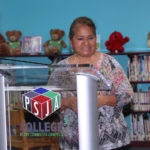BBVA Compass helps tackle Rio Grande Valley’s digital divide with innovative pilot program
Dozens of families in one of the areas where the country’s digital divide is the widest will be getting free internet access thanks in part to BBVA Compass’ steadfast commitment to using the power of digital to create opportunities in its communities.

The City of Pharr, Texas, in the Rio Grande Valley, in collaboration with the Pharr-San Juan-Alamo Independent School District and the Federal Reserve Bank of Dallas, announced on May 12 the creation of the Pharr Life Net pilot program, which will give 50 families broadband access and bilingual training and technical support. The BBVA Compass Foundation was an early supporter of the plan to bridge the digital divide in the Rio Grande Valley, and became the largest corporate sponsor of the strategic plan/feasibility study that led to the Pharr Life Net pilot program. The bank also offered to make its online financial education program available to the students and parents involved. The pilot will be carried out under the leadership of Dr. Ambrosio Hernandez, the mayor of Pharr, and PSJA ISD Superintendent Daniel King.
“The digital divide affects our communities in profound ways and we know it’s particularly pronounced in the Rio Grande Valley, which is an enormously important market for us,” said Onur Genç, the CEO of BBVA Compass, which operates the most bank branches along the border. “We’re committed to finding ways to bridge that divide so that we can connect all of our communities to a brighter future.”

Maria del Carmen Llanas, one of the recipients of free internet access through the Pharr Life Net program in Pharr, Texas, spoke at the press conference in May where the city's mayor and school superintendent announced the pilot project.
In July 2016, the Federal Reserve advised financial institutions that efforts to close the digital divide could be considered favorably in the Community Reinvestment Act exam, which measures how well banks are meeting the credit needs in low- to moderate-income, or LMI, communities. It argued that closing the digital divide will open up opportunities for LMI individuals to gain access to safe financial services and products.
BBVA Compass was ahead of the curve. It recognized the link between the digital divide and financial inclusion in 2015, when the bank’s economists published exhaustive research that found that internet access is now the dominant factor in financial inclusion, overtaking other variables such as race or education levels in determining whether someone participates in the traditional banking system. They developed a Financial Inclusion Metropolitan Index to gauge the financial inclusion levels in more than 250 cities. The McAllen area, of which Pharr is part, was ranked last.
A springboard to action
Since the economists’ study was published, BBVA Compass has moved into action, including its support for the feasibility study for Pharr Life Net. Jordana Barton, senior advisor at the Federal Reserve Bank of Dallas, said Pharr Life Net is the first comprehensive approach to closing the digital divide on the border. It provides a blueprint for bringing together all of the resources across the Rio Grande Valley and replace the current patchwork system that leaves too many people behind. The Pharr Life plan calls for an additional 250 homes to receive broadband internet in the coming months.
“What’s been missing is a robust regional network that connects all of the major anchor institutions and provides the infrastructure to cost-effectively provide broadband or WiFi service to LMI residents,” Barton said. “Pharr Life Net is that prototype, and will serve as a model that could be rolled out along the border. BBVA Compass was very forward-looking in funding the engineering study. It understood that there’s a structural barrier that’s preventing people’s upward economic mobility.”
Pharr Life Net evolved out of the call from a collective impact group, the Digital Opportunity for the Rio Grande Valley, for a regional, intergovernmental fiberoptic network. The DO4RGV includes representatives from the Dallas Fed, The University of Texas Rio Grande Valley, the Texas Association of Telecommunications Officers and Advisors and several city governments, among other entities.

We’re going to have an even greater unbanked population if we don’t find new ways to reach low- to moderate-income people
Smartphone pilot
Pharr Life Net was not, in fact, the first time BBVA Compass has stepped into the breach of the digital divide. Spurred by its economists’ 2015 study on the effect of internet access on financial inclusion, the bank launched a small pilot in 2016 to put internet-connected smartphones in the hands of some of society’s most vulnerable. The bank coordinated with select nonprofit community organizations in Austin, Texas, Riverside, Calif., and Birmingham, Ala., to provide financial literacy education to their clients. The clients were offered the opportunity to receive free prepaid smartphones with one month of service on a network that has a wide selection of free WiFi hotspots if they applied for the BBVA Compass ClearSpend prepaid card. The card comes with a budgeting app that empowers users by tracking spending.
The goal with the pilot was to test the ways BBVA Compass can make an impact on the digital and financial inclusion of underserved communities through mobile internet access, using innovative mobile technologies to deliver banking services affordably with no compromise in quality or convenience.
“This program is powerful because we are approaching the issue of financial inclusion holistically,” said Julieta Falcon, the Underserved and Multicultural Segment Manager for BBVA Compass. “We are providing banking services and also stepping in as an educator of digital financial services and as a mobile phone provider. Our bankers are seeking out the underserved and giving them end-to-end the education, knowledge, training and tools they need to build financial stability. It’s going to help us learn more and better ways to serve these consumers. Above all, we hope this pilot proves that BBVA Compass is a conscientious bank that’s leaning into a digital future and leveraging its creativity to tackle some of society’s most pressing issues.”
Barton, of the Fed, said efforts like that are precisely what the central bank is looking for.
“We’re going to have an even greater unbanked population if we don’t find new ways to reach low- to moderate-income people,” she said. “What we’re calling for is for banks to be more innovative in thinking about how to do that.”